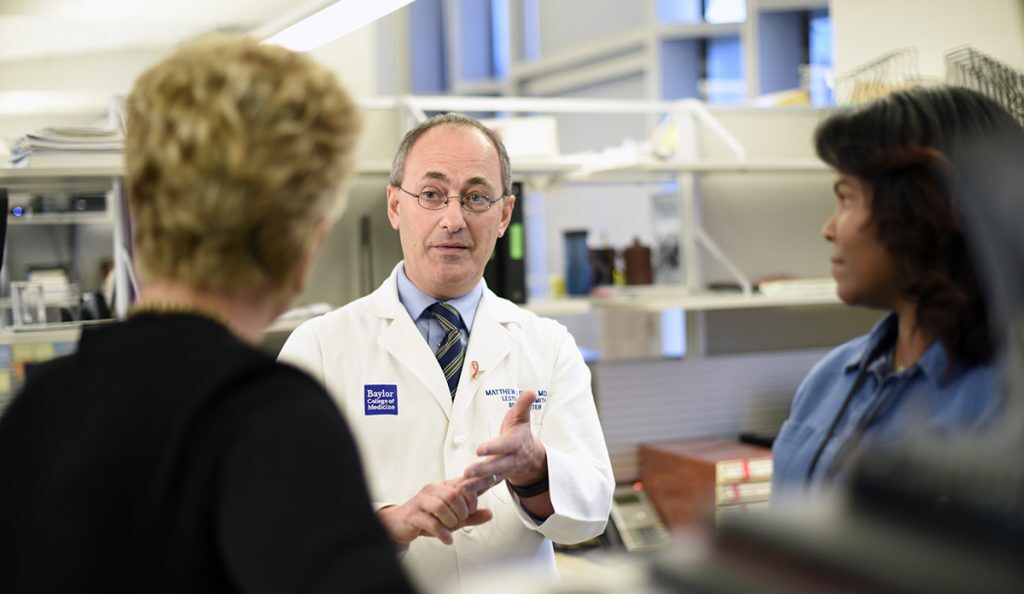In the first study of its kind, Dr. Matthew Ellis demonstrates the clinical value of scaled down proteogenomic analysis of breast tumor biopsies
Proteogenomics allows for simultaneous, multi “-omic” analyses of DNA, RNA (genomics), and proteins (proteomics) in a tissue sample. The information from this set of analyses can identify why a tumor is resistant to treatment and open possibilities for other effective therapies going forward.
The process requires, however, a significant amount of tissue to conduct the analysis—much more than is available from a typical biopsy. In a recent study published in the journal Nature Communications, BCRF researcher Dr. Matthew Ellis describes a new technique to extract and analyze DNA, RNA, and proteins from core-needle biopsy samples from breast cancer patients. By “microscaling” the amount of tissue needed for proteogenomic analysis, Dr. Ellis hopes to bring to the clinic what could previously only be done in a laboratory research setting.
A biopsy is a critical step in cancer diagnosis. To perform most diagnostic breast tumor biopsies, clinicians insert a hollow needle into the core of the suspicious mass (called a core-needle biopsy). The extracted tissue is stained to visualize cellular features and protein markers, such as estrogen receptors and other tumor markers that provide key information about how best to treat the cancer. Because core-needle biopsies are minimally invasive, they have the potential to also be performed in clinical studies to detect molecular changes early on in the course of treatment to determine whether the tumor is responding to that treatment, and if so, how well.
Dr. Ellis and his colleagues conducted such a study to determine whether their microscaled proteogenomics technique could have clinical utility in precision oncology.
Tracking a breast cancer oncogene
Having tested the process in their laboratory models with promising results, Dr. Ellis and his colleagues were ready to test it in a pilot clinical study. The study involved patients with aggressive HER2-positive breast cancer. All the patients received standard neoadjuvant (pre-surgical) therapy with an anti-HER2 drug and chemotherapy.
The researchers took biopsies before treatment and 48 to 72 hours after treatment from 19 patients. Of those, 14 patient samples (a total of 35 biopsies) met the requirements for proteogenomic testing. On average, their DNA and RNA analyses yielded information about more than 46,000 genes. The analyses determined the amounts of more than 10,000 proteins, as well as more than 17,000 active sites (locations on the protein that are either known drug targets or potential targets, or that may serve as biomarkers of response).
As expected, patients responded differently to the therapy, both in terms of molecular features of the tumor and reduction in tumor size. Dr. Ellis and his team focused their analyses on the oncogene ERBB2, which controls expression of HER2.
Their proteogenomic analyses showed a reduction in tumor ERBB2 levels in patients who responded to the therapy, but not in patients whose tumors did not respond. When the researchers further analyzed the tumors that were not responsive, they made two key observations that could shed light on how to improve outcomes for these patients:
- Activation of other pathways for which treatments are available, including activation of the immune system and other druggable pathways were observed.
- While the tumor was categorized as HER2-positive based on standard classification methods (including the presence of HER2), the proteogenomic analysis revealed that HER2 was not always a driving factor in tumor growth, offering an explanation for why some tumors did not respond to HER2-targeted therapy.
In addition, the analysis provided insight into other potential mechanisms of drug resistance, including androgen receptor signaling and lack of immune response.
The right treatment at the right time for every patient
Precision medicine is built on the premise that each patient’s treatment is specific to the patient and the molecular and cellular (genes and proteins) profile of their disease. To be fully realized, precision medicine requires that molecular profiling technologies work in the clinical setting and that treatments are available to target those unique profiles.
Using ERBB2 as their target, Dr. Ellis and his collaborators demonstrated that it is possible to conduct proteogenomic analyses on tumors from a tiny amount of tissue obtained from core-needle biopsies. Once clinically validated, the technology can be used to monitor treatment response and can reveal deeper, fundamental insights into the biology of a patient’s tumor, allowing for more precise and effective treatments.







